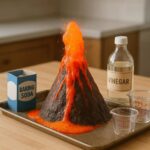Have you ever wondered how water can remain liquid even below its freezing point? This mesmerizing phenomenon is known as supercooling, and it’s a fascinating area of study in physics. In this blog post, we’ll delve into the science behind supercooled water, explore some exciting experiments, and discuss the practical applications of this phenomenon.
What is Supercooled Water?
Supercooled water is water that remains in a liquid state below its freezing point, which is typically 0°C (32°F) at standard atmospheric pressure. This occurs when water lacks nucleation sites, which are small particles or irregularities that allow ice crystals to form. Without these sites, the water molecules cannot easily arrange themselves into a crystalline structure, and thus the water stays liquid even at temperatures below freezing.
The Science Behind Supercooling
Supercooling is a metastable state, meaning it’s not the most stable state for the water, but it can persist indefinitely under the right conditions. The process relies heavily on the absence of nucleation sites. Nucleation sites can be dust particles, air bubbles, or even imperfections on the surface of a container. When these sites are absent, the water molecules don’t have a starting point to form ice crystals, so they remain in a liquid state.
The Role of Nucleation Sites
Nucleation sites play a crucial role in the freezing process. When a nucleus is present, water molecules can gather around it and form ice crystals. In the absence of these sites, the water remains supercooled. This is why, for example, water can sometimes remain liquid in clouds at temperatures well below freezing, only to freeze when it comes into contact with a nucleation site, such as a dust particle or aircraft wing.
Experiments to Try at Home
If you’re curious about supercooling, there are some simple experiments you can try at home to demonstrate this phenomenon.
1. The Ice Cube Experiment
Fill an ice cube tray with water and place it in the freezer. Wait for the water to freeze completely. Once frozen, remove one ice cube and place it in a bowl of room-temperature water. Observe the ice cube as it melts. Now, place another ice cube in a separate bowl of cold water, but not freezing. You’ll notice that the ice cube in the warmer water melts faster, but this experiment isn’t about supercooling. Instead, it’s a simple demonstration of how temperature affects the melting point of ice.
2. The Supercooled Water Droplet Experiment
This experiment requires a bit more preparation but is well worth the effort. You’ll need a clean glass bottle, distilled water, and a way to cool the water below its freezing point. One method is to place the bottle in a mixture of ice and salt, which can lower the temperature below 0°C. Once the water is supercooled, you can add a small nucleation site, such as a tiny ice crystal or a dust particle, to the water. Watch as the water rapidly freezes before your eyes.
3. The Freezing Rain Experiment
Freezing rain is another example of supercooled water in action. To create a simple version at home, you can try the following:
- Fill a spray bottle with water and place it in the freezer until the water is just starting to freeze.
- Remove the bottle from the freezer and immediately spray the water onto a surface that’s below freezing, such as a frozen dessert or another ice cube.
- Observe how the water droplets freeze upon contact with the cold surface.
This experiment mimics the process of freezing rain, where supercooled water droplets in clouds freeze upon contact with a cold surface, creating a layer of ice.
Practical Applications of Supercooling
While supercooling may seem like a curiosity, it has several practical applications in various fields.
1. Cryopreservation
Cryopreservation is the process of preserving tissues, cells, or other biological materials at very low temperatures. Supercooling plays a role in this process, as it can help prevent the formation of ice crystals that can damage biological structures. By cooling tissues slowly and carefully, scientists can induce supercooling, which can then be followed by rapid freezing to preserve the material without ice crystal formation.
2. Cloud Seeding
Cloud seeding is a weather modification technique where substances are introduced into clouds to influence the formation of precipitation. One common method involves seeding clouds with silver iodide, which acts as a nucleation site to encourage the formation of ice crystals. This can enhance precipitation in some cases, helping to alleviate droughts or reduce the impact of hail storms.
3. Food Preservation
Supercooling can also be used in food preservation. By cooling foods to a supercooled state and then rapidly freezing them, the formation of large ice crystals can be prevented. This helps maintain the texture and quality of the food, making it more appealing to consumers.
How to Create Supercooled Water at Home
Creating supercooled water at home is a fun and educational experiment that can be done with minimal equipment. Here’s a step-by-step guide:
Materials Needed:
- Clean glass bottle or container
- Distilled water
- Ice
- Salt
- Food coloring (optional)
Instructions:
-
Prepare the Water: Fill the glass bottle with distilled water. If desired, add a few drops of food coloring to make the experiment more visually appealing.
-
Chill the Water: Place the bottle in a mixture of ice and salt. The salt lowers the freezing point of the ice, allowing the water to cool below 0°C.
-
Wait for Supercooling: Stir the water occasionally as it chills. After about 30 minutes to an hour, the water should be supercooled and still in a liquid state, despite being below its freezing point.
-
Induce Freezing: To observe the freezing process, you can add a small nucleation site to the water, such as an ice crystal or a dust particle. Watch as the water rapidly freezes before your eyes.
Safety Tips:
- Handle the ice and salt mixture carefully, as it can be slippery.
- Keep the experiment out of reach of children and pets.
- Ensure the bottle is clean and free of contaminants, as impurities can act as nucleation sites and prevent supercooling.
The Magic of Supercooling
Supercooling is a fascinating phenomenon that challenges our everyday understanding of how water behaves. By understanding the science behind it, we can gain insights into the natural world and develop innovative technologies. Whether you’re conducting experiments at home or exploring the practical applications of supercooling, this phenomenon is sure to captivate and inspire.
Conclusion
Supercooled water is a remarkable example of how water can defy its usual behavior under the right conditions. By understanding the role of nucleation sites and how to induce supercooling, we can unlock new ways to manipulate and utilize water in various fields. Whether you’re a scientist, a student, or simply someone curious about the natural world, supercooled water is sure to leave you in awe of the magic that lies just beyond our everyday observations.
So the next time you see ice forming, remember the intricate dance of molecules and the critical role of nucleation sites in determining the state of water. Who knows? You might just discover a new way to harness the power of supercooled water for yourself.



